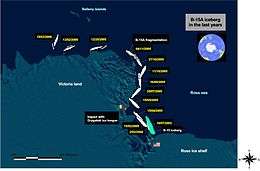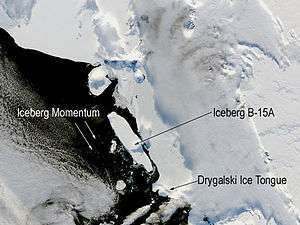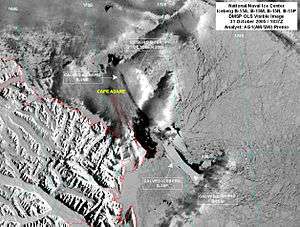Iceberg B-15
Iceberg B-15 was the world's largest recorded iceberg.[Note 1] It measured around 295 kilometres (183 mi) long and 37 kilometres (23 mi) wide, with a surface area of 11,000 square kilometres (4,200 sq mi)—larger than the whole island of Jamaica. Calved from the Ross Ice Shelf of Antarctica in March 2000, Iceberg B-15 broke up into smaller icebergs, the largest of which was named Iceberg B-15A. In 2003, B-15A drifted away from Ross Island into the Ross Sea and headed north, eventually breaking up into several smaller icebergs in October 2005.[2] As of 2018, a large piece of the original iceberg was steadily moving northward, located between the Falkland Islands and South Georgia Island.
_(NSF).jpg)
History


In the last weeks of March 2000, Iceberg B-15 calved from the Ross Ice Shelf near Roosevelt Island, Antarctica.[3][4] The calving occurred along pre-existing cracks in the ice shelf.[3] The iceberg measured around 295 kilometres (183 mi) long and 37 kilometres (23 mi) wide, with a surface area of 10,915 square kilometres (4,214 sq mi)—nearly as large as the island of Jamaica,(10,991 square kilometres (4,244 sq mi)). Scientists believe that the enormous piece of ice broke away as part of a long-term natural cycle, which occurs every fifty to one hundred years.[3] In 2000, 2002, and 2003, Iceberg B-15 broke up into several pieces, the largest of which, B-15A, covered 6,400 square kilometres (2,500 sq mi) of the sea surface.[5]
In November 2003, after the separation from B-15J, B-15A drifted away from Ross Island on the open waters of the Ross Sea. In December 2003, a small knife-shaped iceberg, B-15K (about 300 km²), detached itself from the main body of B-15A and started drifting northward. By January 2005, prevailing currents caused B-15A to drift toward the Drygalski Ice Tongue, a 70-kilometre (43 mi) long extension of the land-based David Glacier, which flows through the coastal mountains of Victoria Land.[6] A few kilometres from the ice tongue, the iceberg became stranded on a shallow seamount before resuming its northward course.[7] On 10 April 2005, B-15A collided with the ice tongue, breaking off the tip of the ice tongue; the iceberg seemed unaffected by the collision.[6]
Iceberg B-15A continued to drift along the coast leaving McMurdo Sound. On 27–28 October 2005, the iceberg ran aground off Cape Adare in Victoria Land and broke into several smaller pieces, generating seismic signals that were detected as far away as the Amundsen-Scott South Pole Station [8][9] the largest of which was still named B-15A (now measuring approximately 1,700 square kilometres (660 sq mi)). Three additional pieces were named B-15P, B-15M, and B-15N. Iceberg B-15A then moved farther up north and broke up into more pieces. These were spotted by air force fisheries patrol on 3 November 2006. On 21 November 2006 several large pieces were seen just 60 km off the coast of Timaru, New Zealand—the largest measured about 18 kilometres (11 mi), rising 37 metres (121 ft) from the surface of the ocean.
As of 2018, four pieces remain that are large enough to be tracked by the National Ice Center (at least 20 square nautical miles).[2] One piece, B-15Z, measures 10 nautical miles by 5 nautical miles. It was located in the southern Atlantic ocean, about 150 nautical miles northwest of South Georgia Island. As it continues its move northward, the speed of melt increases. Most icebergs do not last long this far north.[10]
Effect on Antarctic ecology

On 29 January 2001, researchers from the University of Chicago and the University of Wisconsin installed weather and Global Positioning System instruments on Iceberg B-15A. It was the first time an iceberg had been monitored in this way. The data gathered led to an unprecedented understanding of how giant icebergs make their way through the waters of Antarctica and beyond.
Iceberg B-15A collided with the Drygalski Ice Tongue on 10 April 2005, breaking off an 8-square-kilometre (3.1 sq mi) section of the ice tongue. Antarctic maps needed to be redrawn.
B-15A prevented ocean currents and winds from assisting in the 2004–2005 summer break-up of the sea ice in McMurdo Sound, and was an obstacle to the annual resupply ships to three research stations. The floe was expected to cause a catastrophic decline in the population of Adélie penguins, as it added considerable distances which parent penguins must travel back from the sea to their chicks. Weddell seals and Skuas are also inhabitants of McMurdo Sound and their populations may have been affected as well.
In October 2006, a study showed that a large storm in the Gulf of Alaska generated a trans-Pacific ocean swell that may have contributed to breaking B15-A into many pieces on 27 October 2005.[11] The swell travelled 13,500 kilometres (8,400 mi) from Alaska to Antarctica over six days. Scientists are studying this event as an example of how weather in one area can have effects in other parts of the world, and with concern over the effects on global warming.[12]
A more detailed study in 2010, however, shows that the iceberg breakup was principally caused by repeated grounding with near-coastal bathymetry near Cape Adare, Victoria Land.[13]
Satellite images
 Iceberg B-15A drifting toward the Drygalski Ice Tongue before the collision, 2 January 2005 (NASA) |
 Iceberg B-15 after break-up, showing B-15M, B-15N, and B-15P, 31 October 2005 (DMSP) |
See also
- List of recorded icebergs by area
- McMurdo Sound
- Encounters at the End of the World, a Werner Herzog documentary which contains some footage of B-15
References
Notes
- Iceberg B-15 is the largest iceberg recorded by satellite photography. In 1956, an iceberg in the Antarctic was reported to be an estimated 333 kilometres (207 mi) long and 100 kilometres (62 mi) wide. Recorded before the era of satellite photography, the 1956 iceberg's estimated dimensions are less reliable.[1]
Citations
- Goering, Laurie (24 March 2000). "Mammoth Iceberg Is Born In Antarctic". Chicago Tribune. Retrieved 18 February 2014.
- Specktor, Brandon (8 June 2018). "Antarctica's Largest Iceberg Is About to Die ... Near the Equator". Space.com. Retrieved 1 August 2019.
- "Massive Iceberg Peels Off from Antarctic Ice Shelf". National Science Foundation. 22 March 2000. Retrieved 17 February 2014.
- "Biggest iceberg tracked from space". The ATSR Project. 9 May 2000. Retrieved 17 February 2014.
- Arrigo, Kevin R.; Van Dijken, Gert L. (January–February 2004). "Annual changes in sea-ice, chlorophyll a, and primary production in the Ross Sea, Antarctica". Deep-Sea Research Part II: Topical Studies in Oceanography. 51 (1–3): 117–138. Bibcode:2004DSRII..51..117A. doi:10.1016/j.dsr2.2003.04.003.
- "Pile-up as berg hits Antarctica". BBC. 19 April 2005. Retrieved 17 February 2014.
- Bhattacharya, Shaoni (19 April 2005). "World's largest iceberg 'goes bump in the night'". New Scientist. Retrieved 17 February 2014.
- MacAyeal, D., Okal, E., Aster, R., Basis, J., Brunt, K., Cathles, L. Mac. Drucker, R., Kim, Y-J., Martin, S., Okal, M., Sergienko, O., Sponsler, M., Thom, J., Transoceanic wave propagation links iceberg calving margins of Antarctica with storms in tropics and northern hemisphere, Geo. Res. Lett., 33, L17502, doi:10.1029/2006GL027235, 2006.
- Martin, S., Drucker, R., Aster, R., Davey. F., Okal E., Scambos T., and MacAyeal, D., Kinematic and seismic analysis of giant tabular iceberg breakup at Cape Adare, Antarctica, J. Geophys. Res., 115, B06311, doi:10.1029/2009JB006700, 2010.
- Eleanor Imster (11 June 2018). "End of the journey for iceberg B-15?". Retrieved 22 July 2019.
- MacAyeal, Douglas R.; et al. (12 September 2006). "Transoceanic wave propagation links iceberg calving margins of Antarctica with storms in tropics and Northern Hemisphere". Geophysical Research Letters. 33 (17): L17502. Bibcode:2006GeoRL..3317502M. doi:10.1029/2006gl027235.
- Harris, Richard (5 October 2006). "Alaskan Storm Plays Role of Butterfly for Antarctica". National Public Radio. Retrieved 17 February 2014.
- Martin, Seeley.; et al. (18 June 2010). "Kinematic and seismic analysis of giant tabular iceberg breakup at Cape Adare, Antarctica". Journal of Geophysical Research: Solid Earth. 115 (B6): B06311. Bibcode:2010JGRB..115.6311M. doi:10.1029/2009jb006700.
Further reading
- Stone, Gregory S. (2003). Ice island : expedition to Antarctica's largest iceberg. Boston, Massachusetts: New England Aquarium Press, National Geographic Society (U.S.). ISBN 1593730179. OCLC 52739140.
External links
| Wikimedia Commons has media related to Iceberg B-15. |
- ESA: Situation Around Balleby Islands; Icebergs B-15A, B-15N, C-19A (2 March 2006)
- ESA: Envisat Shows Behemoth B-15A Iceberg Breaking Up (7 November 2005)
- NASA: Antarctic Iceberg Gets Stuck (6 January 2005)
- B-15A Iceberg Blocks McMurdo Sound (NASA Earth Observatory), (2004-12-15)
- Tracking the World's largest Iceberg B 15 (video)